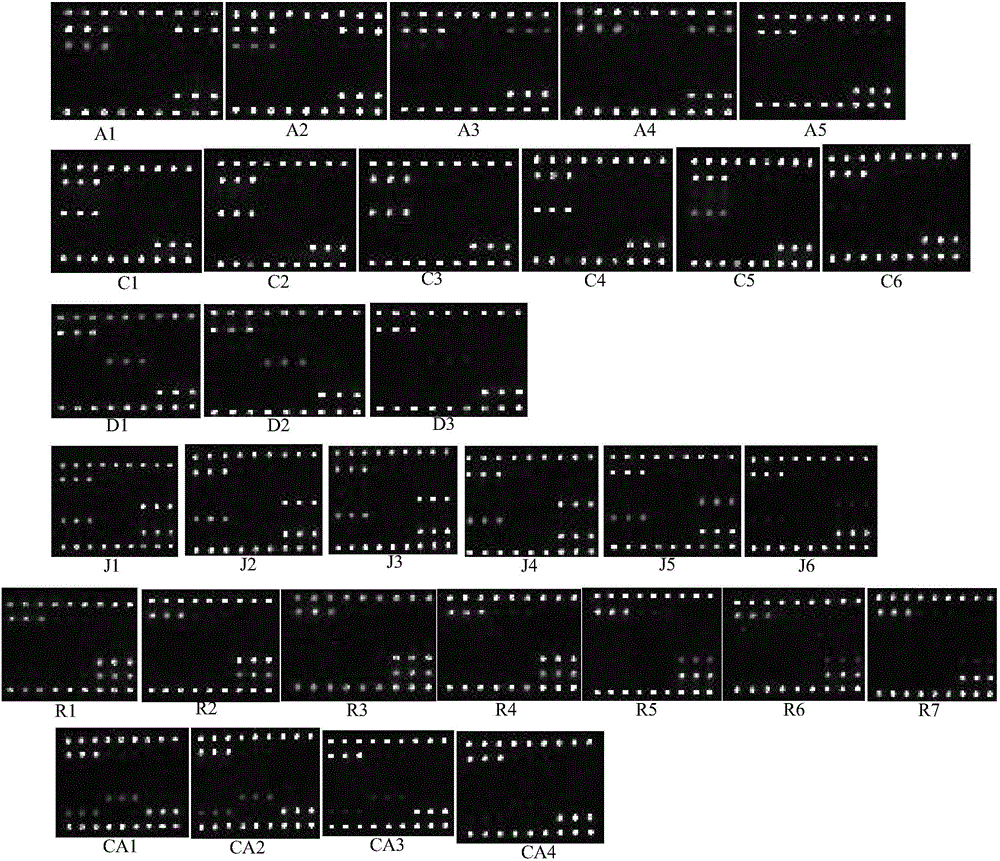Gene chip, kit and method for detecting three viruses for immunosuppression disease of chickens
A gene chip and immunosuppression technology, which is applied in the field of gene chips for detecting three kinds of immunosuppressive disease viruses in chickens, can solve the problems that high specificity and large batches of samples cannot be detected.
- Summary
- Abstract
- Description
- Claims
- Application Information
AI Technical Summary
Problems solved by technology
Method used
Image
Examples
Embodiment 1
[0100] Embodiment 1. The design of probe and primer and the preparation of gene chip
[0101] Step 1. Design of Specific Probes
[0102] 459 complete cDNA sequences of the reference strains of CAV, REV, and ALV A, C, D, and J subgroups were collected from Genbank. 459 sequences were built according to species, and 13 reference strain sequences were selected for each subgroup after comparison, among which the GenBank number of the CAV reference strain sequence was M55918; the REV reference strain sequence GenBank number was DQ387450, NC006934; The reference strain sequence GenBank number of ALV A subgroup is HM452339, M19113, M14901, HM452340, AB617819; the reference strain sequence GenBank number of ALV C subgroup is V01197; the reference strain sequence GenBank number of ALV D subgroup is D10652; The reference strain sequence GenBank numbers of ALV J subgroup are AY027920 and GU982307.
[0103] These sequences were compared with the Clustal W program of DNAStar software to ...
Embodiment 2
[0116] Embodiment 2. Preparation of the DNA template of the sample to be tested
[0117] The CAV tissue virus (that is, the plasmid carrying CAV cDNA) preserved in our laboratory was extracted with the DNA extraction kit from QIAGEN, and the nucleic acid concentration was finally detected, and stored at -20°C for future use.
[0118] The corresponding target sequences of REV and ALV (subgroups A, C, D, and J) have been synthesized by Shanghai Sangon Biotechnology Co., Ltd. and connected to the PCU57 vector plasmid. Take the bacterial liquid culture containing the synthetic plasmid, and use Tiangen Company’s plasmid small The test kit extracts the plasmid from the bacterial culture, and finally detects the nucleic acid concentration, and stores it at -20°C for later use.
Embodiment 3
[0119] Example 3. Optimizing the Multiplex PCR Amplification System
[0120] The purpose of multiplex PCR is to amplify the target sequence with as few primers as possible, so as to reduce the experimental time and steps, and improve the detection efficiency; the two multiplex PCR systems are: system 1, which can simultaneously amplify ALV A and C in the same system The target sequences of the four subgroup strains of , D, and J; System 2: The target sequences of two strains of CAV and REV can be amplified simultaneously in the same system.
[0121] In this study, the gene sequence of a reference strain was selected as a representative sequence in ALV, CAV, and REV, and the concentration was adjusted to 1ng / μL, and then mixed in equal volumes, and the above primers were used for PCR amplification respectively. The initial concentration of primers Both are 10 μmol / L. Through repeated experiments and optimization, the finally determined reaction system and reaction conditions ar...
PUM
 Login to View More
Login to View More Abstract
Description
Claims
Application Information
 Login to View More
Login to View More - R&D Engineer
- R&D Manager
- IP Professional
- Industry Leading Data Capabilities
- Powerful AI technology
- Patent DNA Extraction
Browse by: Latest US Patents, China's latest patents, Technical Efficacy Thesaurus, Application Domain, Technology Topic, Popular Technical Reports.
© 2024 PatSnap. All rights reserved.Legal|Privacy policy|Modern Slavery Act Transparency Statement|Sitemap|About US| Contact US: help@patsnap.com










